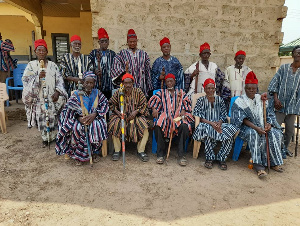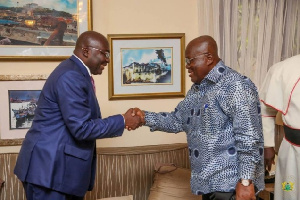Opinions of Wednesday, 11 October 2023
Columnist: Jocob Ahiah
Vagla chieftaincy system: The Kunlog tradition area
The Kunlog Traditional Area is in the Sawla-Tuna-Kalba District of the Savannah Region. The traditional capital is KUNLOG. Kunlog is the community's original name and is currently spelled as Jelinkon. In all traditional matters, the original name Kunlog is retained and used by the Aborigines of the land who are the Vagla. The Vagla are the indigenes or the indigenous people the custodians.
Land Boundaries according to the Vagla Customs, Traditions, and Landownership System Kunlog is very close to Sawla (6 Miles). The Kunlog Traditional Area shares land boundaries to the North with Jang (which is the oldest of the Vagla communities-towns/villages) and shares borders with the Tampulma Tribe of which many of the communities are now extinct due to the creation of the Game and Wildlife Division (currently known as the Mole National Park).
To the East of Kunlog, it shares land boundaries with the Hanga people of which most of the communities are extinct due to the presence of the Mole National Park (National Wildlife Reserve).
To the South, Kunlog shares land boundaries with the Chorbang Traditional Area and the Kunlog land ends with land boundaries with Teinbol near Sor-nyor in the Choruba Nation of the Great Vagla Nation State with such landownership system arrangements existing for several centuries.
The Kunlog land boundaries extend beyond Nyange towards Kalinbol (now extinct)
due to the atrocities of the Samori Toure War of 1895-97 in which Kunlog lost several communities within the traditional area. However, the Kunlog village was spiritually protected from the Samori War due to the power of the supreme god or deity known as Kunlog Heu.
Another Vagla village that escaped the brutal War of Samori Toure was Sornyor because of the protective powers of the powerful Shrine in Sor-nyor (now spelt Sonyo). This powerful god/shrine is called Sonyo Kipo.
To the West of Kunlog, the Kunlog Traditional Area shares land boundaries with Dagbigi. One of the oldest Vagla communities in the history of the Vagla Tribe. Dagbigu is located very close to the Black Volta. This shows the landmass of the Kunlog Traditional Area which is too vast. It is important to note that Sawla emerged from the Kunlog-Dagbigu lands. Thus, Sawla is a relatively new town/village per Vagla records of settlement patterns in the Vagla Nation of the
Great Vagla Nation State history.
Another village with close links to Kunlog is Nakwabi (an offspring of Kunlog). For this reason, the Nakwabi Traditional Area has almost the same Chieftaincy System as Kunlog, which is an embedded Heuhin as both Koro and the Heuhin (dual roles/officeholder).
Kunlog chieftaincy system:
Kunlog is among the earliest Vagla settlements. It is among the first five older villages in Vagla history. From Jang, Kunlog was established with the supreme traditional leader dating back to the 13th Century under the legendary Heuhin Luuge Chii. The oral history of the Vagla suggests that Heuhin Luuge Chii was the first to have occupied the most sacred skin in the Kunlog Traditional Area.
The Paramount Chief in the Kunlog Traditional Area is the Kunlog Heuhin.
Archival and oral history have several Chiefs (Heuhina) that occupied the Kunlog Heu, prominent among the Heuhina is Heuhin Baakuuh who was on the throne (skin) at the time of the arrival of the Ngbanya Tribe or people. Heuhin Baakuuh was popular for his bravery, war prowess, and frequent visits to the Senior Town of Jang.
It is believed that whenever Baakuuh is mentioned the response is Kerewia. Thus, the full throne (skin) name became known as Baakuuh Kerewia. Moreover, the Vagla history of Kunlog points to several engagements with the Jang People, and the Beel People. Kunlog problems are often mediated by Jang and Beel Koro. Heuhin Baakuuh is a legendary Heuhin of Kunlog and his name still rings in the ears of
the people of Kunlog. In history, he is known as the 15-16th Century Great Kunlog Chief (Heuhin).
Some modern eras (latest Chiefs of Kunlog/Heuhina) include:
Heuhin Chonga
Heuhin Mwiri (JIUIRI VUG)
Heuhin Laage
Heuhin Siakoni
Heuhin Kani, and
The immediate late Heuhin is called Heuhin Kwaja Jimah Mahama. As of October 2023, there is no successor to Heuhin Jimah Mahama. All hands on deck for an end to the chieftaincy crisis.
The Kunlog Heuhin occupies the highest skin in the Kunlog Traditional Area known as Kor- Zen Hona/Hon (Paramountcy).
Kunlog Kor-Jiga (Sub-Chiefs):
The Heuhin is assisted by two sub-chiefs (Zagbere Koro and Sigto Koro). These two are the most senior to the skin. According to the Kunlog Chieftaincy system, the supreme chief skin (Kunlog Heuhin) revolves around the two senior chiefs (Koro Sigtochere and Koro Zagbere).
These two traditional chiefs are very revered in the Kunlog Traditional Area. There is also another powerful Chief with a specific traditional role known as Kunlog Kacha Koro. This chief is highly revered, and it is the origin of the Chankpalge Kii (where the wild animal Antelope is taboo in Kunlog). Indigenes of Kunlog do not eat antelope. This same taboo applies to the offspring town/village of Nuk))be (Nakwabi).
Other Sub-Chiefs who are representatives of the Kunlog Heuhin in the Kunlog Traditional Area include Wegubol Heuhin, Kodanyina Heuhin, Muubol Heuhin, Zolibol Heuhin among others in respective communities. All three types of sub-chiefs are under the direct authority of Kunlog Heuhin. The Kunlog Chieftaincy
System (Vagla Upper Chiefdom) is highly centralized with three beautiful, decentralized units (three sub-chief systems namely Kacha Koro (Kachanaa), two prominent chiefs (Zagbere and Sigtochere), and the Heuhina of the various communities.
These Heuhina often gather farm produce from the various settler communities to support the performance of the Annual Kunlog Heu Festival. Also, the Kunlog has two powerful or sacred streams that matter most in the spirit of the waters namely PUGZA and POZENG.
Kunlog chieftaincy and succession system:
The occupier of the Kunlog Kor-zen (paramountcy goes with the appellation Siayo or Jara. The selection process is in two stages with the Queen Mothers Council and the Elders Council. Thus, the enskinment is done where the elders meet and select the candidate and give the sandals, fetish priest knife, and walking stick to the qualified person (as the nominated candidate).
The enskinment is done by the Clan Elder (Naboma) of the designated Sal. Two
royal gates exist in Kunlog in which the Kunlog Heu rotate between the two gates namely VAGLIKORO SAL AND SABIZI SAL. Currently, there is a succession crisis or dispute between the two most senior Chiefs of the Kunlog Heu. We salute the sacrifices the two great Sub-Chiefs have offered to the Kunlog Heu and their sacrifices to the promotion of the Kunlug Chiefdom.
May the ancestors of Kunlug and that of Vagla land help to resolve the outstanding dispute between ZAGBERE KORO VUG JIGA/JIMAH AND SIGTOG KORO
DOMYIEREBE.
Records in Kunlog Chief Domyierebe served about four decades as SIGTOG-
CHIRI (SIGTOG KORO) where Chief Vug Jiga served Kunlog Heu for about two decades. The crisis is also about the rotational patterns. Other issues to be addressed in the crisis include lineage, years of service, acceptance/rejection, and the two Councils. The Queen Mothers Council and Elders Council need some clarifications/codification. This calls for unity of talk, rituals on whom the mantle falls, and the powers of the Queens/Elders.











